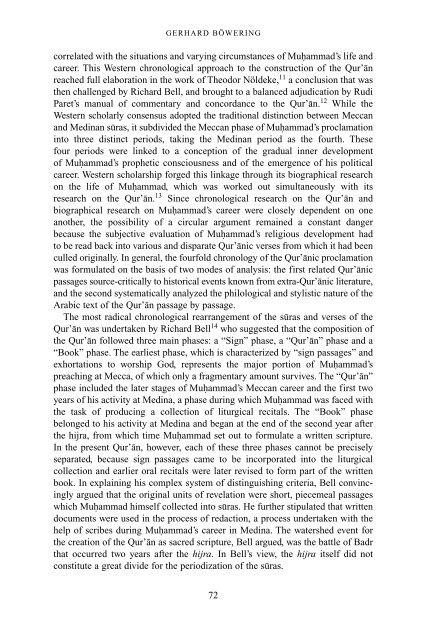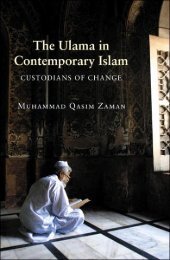The Qur'an in its historical context (pdf - Islam and Christian-Muslim ...
The Qur'an in its historical context (pdf - Islam and Christian-Muslim ...
The Qur'an in its historical context (pdf - Islam and Christian-Muslim ...
You also want an ePaper? Increase the reach of your titles
YUMPU automatically turns print PDFs into web optimized ePapers that Google loves.
GERHARD BÖWERING<br />
correlated with the situations <strong>and</strong> vary<strong>in</strong>g circumstances of Muhammad’s life <strong>and</strong><br />
career. This Western chronological approach to the construction of the Qur’an<br />
reached full elaboration <strong>in</strong> the work of <strong>The</strong>odor Nöldeke, 11 a conclusion that was<br />
then challenged by Richard Bell, <strong>and</strong> brought to a balanced adjudication by Rudi<br />
Paret’s manual of commentary <strong>and</strong> concordance to the Qur’an. 12 While the<br />
Western scholarly consensus adopted the traditional dist<strong>in</strong>ction between Meccan<br />
<strong>and</strong> Med<strong>in</strong>an suras, it subdivided the Meccan phase of Muhammad’s proclamation<br />
<strong>in</strong>to three dist<strong>in</strong>ct periods, tak<strong>in</strong>g the Med<strong>in</strong>an period as the fourth. <strong>The</strong>se<br />
four periods were l<strong>in</strong>ked to a conception of the gradual <strong>in</strong>ner development<br />
of Muhammad’s prophetic consciousness <strong>and</strong> of the emergence of his political<br />
career. Western scholarship forged this l<strong>in</strong>kage through <strong>its</strong> biographical research<br />
on the life of Muhammad, which was worked out simultaneously with <strong>its</strong><br />
research on the Qur’an. 13 S<strong>in</strong>ce chronological research on the Qur’an <strong>and</strong><br />
biographical research on Muhammad’s career were closely dependent on one<br />
another, the possibility of a circular argument rema<strong>in</strong>ed a constant danger<br />
because the subjective evaluation of Muhammad’s religious development had<br />
to be read back <strong>in</strong>to various <strong>and</strong> disparate Qur’anic verses from which it had been<br />
culled orig<strong>in</strong>ally. In general, the fourfold chronology of the Qur’anic proclamation<br />
was formulated on the basis of two modes of analysis: the first related Qur’anic<br />
passages source-critically to <strong>historical</strong> events known from extra-Qur’anic literature,<br />
<strong>and</strong> the second systematically analyzed the philological <strong>and</strong> stylistic nature of the<br />
Arabic text of the Qur’an passage by passage.<br />
<strong>The</strong> most radical chronological rearrangement of the suras <strong>and</strong> verses of the<br />
Qur’an was undertaken by Richard Bell 14 who suggested that the composition of<br />
the Qur’an followed three ma<strong>in</strong> phases: a “Sign” phase, a “Qur’an” phase <strong>and</strong> a<br />
“Book” phase. <strong>The</strong> earliest phase, which is characterized by “sign passages” <strong>and</strong><br />
exhortations to worship God, represents the major portion of Muhammad’s<br />
preach<strong>in</strong>g at Mecca, of which only a fragmentary amount survives. <strong>The</strong> “Qur’an”<br />
phase <strong>in</strong>cluded the later stages of Muhammad’s Meccan career <strong>and</strong> the first two<br />
years of his activity at Med<strong>in</strong>a, a phase dur<strong>in</strong>g which Muhammad was faced with<br />
the task of produc<strong>in</strong>g a collection of liturgical recitals. <strong>The</strong> “Book” phase<br />
belonged to his activity at Med<strong>in</strong>a <strong>and</strong> began at the end of the second year after<br />
the hijra, from which time Muhammad set out to formulate a written scripture.<br />
In the present Qur’an, however, each of these three phases cannot be precisely<br />
separated, because sign passages came to be <strong>in</strong>corporated <strong>in</strong>to the liturgical<br />
collection <strong>and</strong> earlier oral recitals were later revised to form part of the written<br />
book. In expla<strong>in</strong><strong>in</strong>g his complex system of dist<strong>in</strong>guish<strong>in</strong>g criteria, Bell conv<strong>in</strong>c<strong>in</strong>gly<br />
argued that the orig<strong>in</strong>al un<strong>its</strong> of revelation were short, piecemeal passages<br />
which Muhammad himself collected <strong>in</strong>to suras. He further stipulated that written<br />
documents were used <strong>in</strong> the process of redaction, a process undertaken with the<br />
help of scribes dur<strong>in</strong>g Muhammad’s career <strong>in</strong> Med<strong>in</strong>a. <strong>The</strong> watershed event for<br />
the creation of the Qur’an as sacred scripture, Bell argued, was the battle of Badr<br />
that occurred two years after the hijra. In Bell’s view, the hijra <strong>its</strong>elf did not<br />
constitute a great divide for the periodization of the suras.<br />
72



